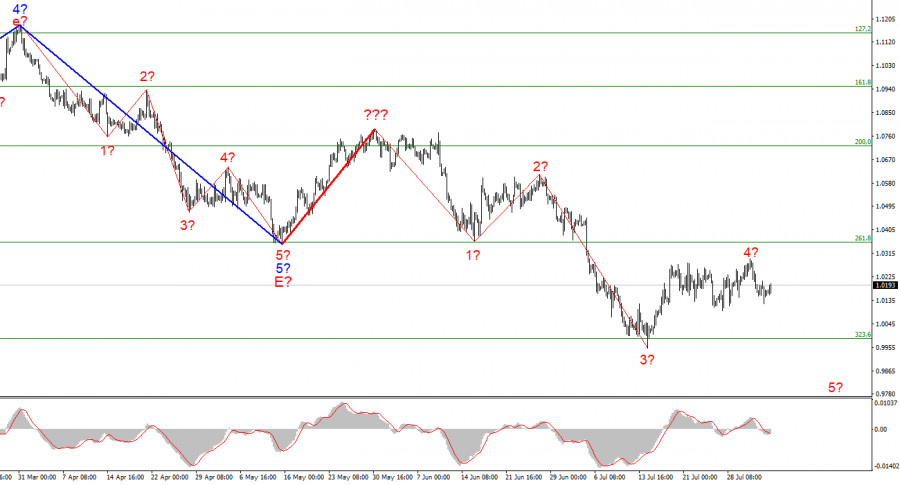

The wave marking of the 4-hour chart for the euro/dollar instrument does not require new adjustments. I recently built a new wave markup that does not yet consider the rising wave marked with a bold red line. The whole wave structure can be complicated an unlimited number of times. It is the disadvantage of wave analysis since any structure can always take a more complex and extended form. Therefore, now I propose to work on simpler wave structures that contain waves of a lower scale.
As you can see, the construction of a descending wave has presumably begun, which may be wave 5 of a new downward trend section. If this assumption is correct, the instrument will continue to decline with targets below 1.0000. The supposed wave 4 took a three-wave form and surprisingly coincided with the peak of the supposed wave 4, according to the British. Thus, perhaps this is the moment the market has been waiting for. The euro and the pound are now coinciding in their wave markings, suggesting a new decline. The wave pattern may still take a more complex form, which we would like to avoid, but the wave pattern looks very convincing at the moment.
The demand for the dollar is growing very slowly.
The euro/dollar instrument rose by only 20 basis points on Thursday. Such a weak change in the pair's exchange rate does not allow making any additions to the current wave marking, which assumes the continuation of the construction of the descending wave 5. To do this, it is necessary that the demand for the US dollar grows, not decreases. And the news background has always been a very good driver for the market. However, there were not so many important events and news this week that could significantly increase the demand for the US currency. I expected that the deterioration of the geopolitical situation in the world would provide more serious support to the dollar. However, the market very quickly realized that the media inflated conflicts could end quite well, since none of the parties to any conflict is eager to unleash hostilities. Of course, all parties say that, if necessary, they will defend their rights/territories and protect their citizens, but military actions are very costly, and they always turn into serious losses for the countries participating in the conflict. Therefore, China will think ten times before trying to seize Taiwan.
The last day of the week promises to be very interesting. The news background should be very strong, as the Nonfarm Payrolls report always causes a market reaction. We are waiting for a strong value; as Jerome Powell said last week, the labor market in America is in very good condition, and unemployment is at the lowest in the last 50 years. If this trend continues, the US currency will sooner or later go into growth. Otherwise, we may see the quotes moving away from the reached lows, but this will not mean that wave 5 will not complete its construction. After all, it can only be an internal wave of 5, after which the decline in the quotes of the instrument will resume. In general, all the attention is on the payrolls.
General conclusions
Based on the analysis, I conclude that the construction of the downward trend section continues. If so, it is now possible to sell the instrument with targets located near the estimated 0.9397 mark, which is equal to 423.6% Fibonacci, for each MACD signal "down" in the calculation of the construction of wave 5. Wave 4 can already be completed.

At the higher wave scale, the wave marking of the descending trend segment becomes noticeably more complicated and lengthens. It can take on almost any length, so I think it's best to isolate three and five-wave standard wave structures and work on them.